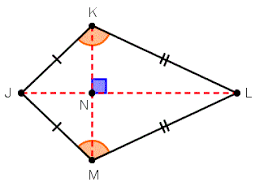Which of the following shapes is a kite?
- A square.
- A rhombus.
- A parallelogram.
- A trapezoid.
- An isosceles trapezoid.
- A square.
- A rhombus.
- A parallelogram.
- A trapezoid.
- An isosceles trapezoid.
2 Answers
As explained
Explanation:

Kite is a special shape.
-
No similarity with parallelogram or rectangle as opposite sides are not parallel and not equal.
-
Not similar to trapezoid or isosceles trapezoid and no one pair of opposite sides are parallel.
-
Not similar to square or rhombus as opposite sides are not parallel and all the four sides are not equal as also diagonals donot bisect each other.
-
Similar to square and rhombus in that the diagonals intersect each other at right angles.
-
It is not a cyclic quadrilateral too.
Properties of KITE :
Two pairs of adjacent sides are equal (
One pair of opposite angles equal(
Diagonals intersect each other at right angles
It depends...
Explanation:
When classifying geometric shapes there is often a choice between inclusive and exclusive definitions.
For example, is a square also a rectangle?
The inclusive definition would say yes, while the exclusive definition would say no.
The problem is that people do not agree on whether the inclusive or exclusive definition is more correct - different authors use different definitions.
In order to answer the given question, we really need to understand whether the author intended the use of inclusive or exclusive definitions.
It seems clear to me that the author intended an inclusive interpretation since otherwise any 'special case' would not be counted as a kite.
In which case, a kite could be defined as follows:
A kite is a quadrilateral with two pairs of adjacent sides of identical length.
Note that this most general of definitions does not exclude concave kites, which are sometimes called darts.
With this definition, we find that:
- Squares are always kites.
- Rhombuses are always kites.
- A parallelogram can be a kite, but only if it is also a rhombus.
- A trapezoid (British: trapezium) can be a kite, but only if is also a rhombus.
- An isosceles trapezoid can be a kite, but only if it is also a square.
So the best answer to the question is probably 1. and 2.

